With more cases of Eastern equine encephalitis being reported throughout the United States, both veterinarians and doctors are warning the public about this zoonotic virus that affects both horses and humans.

Horses and humans = Dead end hosts
Also known as sleeping sickness, Eastern equine encephalitis virus (EEE) is a zoonotic virus found in North, Central and South America as well as the Caribbean.
Also known as sleeping sickness, Eastern equine encephalitis virus (EEE) is a zoonotic virus found in North, Central and South America as well as the Caribbean. In particular, transmission is most common around freshwater, hardwood swamps and coastal plains including the Great Lakes region as well as the Atlantic and Gulf Coast states. In Ontario, EEE has been found in horses that reside in the province or have become infected while travelling.
In many states, Eastern equine encephalitis is a reportable disease and authorities remind everyone that according to state regulations, all veterinarians practicing veterinary medicine shall report any equine encephalomyelitis condition to the State Veterinarian within 24 hours after making a diagnosis or tentative diagnosis of any such disease. In most cases, the report may be made by telephone, fax, or electronic mail.
How is Eastern equine encephalitis transmitted?
The Eastern equine encephalitis virus (EEE) can infect a wide range of hosts including mammals, birds, reptiles and amphibians. Infection occurs through the bite of an infected mosquito.
The virus itself is maintained in nature through a cycle between Culiseta melanura mosquitoes and birds. Culiseta melanura mosquitoes feed almost exclusively on birds, so they are not considered an important vector of EEE to humans or other mammals.
Transmission of EEE to humans requires mosquito species capable of creating a “bridge” between infected birds and uninfected mammals. Other species of mosquitoes (including Coquiletidia perturbans, Aedes vexans, Ochlerotatus sollicitans and Oc. Canadensis) become infected when they feed on infected birds. These infected mosquitoes will then occasionally feed on horses, humans and other mammals, transmitting the virus. However, humans, horses and other infected mammals do not circulate enough of the EEE virus within their blood to infect additional mosquitoes, so they are considered ‘dead-end hosts’.
Transmission is most common around freshwater, hardwood swamps and coastal plains including the Great Lakes region as well as the Atlantic and Gulf Coast states. In Ontario, EEE has been found in horses that reside in the province or that have become infected while travelling.
Similar to West Nile virus (WNv), the amount of virus found in nature increases throughout the summer as more birds and mosquitoes become infected.
